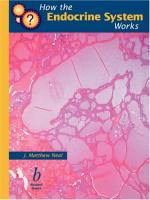|
This section contains 321 words (approx. 2 pages at 300 words per page) |
Endocrine glands are collections of tissue which manufacture and release chemical messengers called hormones. Hormones are chemicals which affect the functioning of some distant organ or tissue.
Unlike exocrine glands (such as sweat glands and salivary glands), endocrine glands do not have ducts (ducts are tube-like passageways through which substances produced in an exocrine gland are transported). Instead, endocrine glands pass their products directly into the bloodstream. Endocrine hormones are thus transported to the organ or tissue where they will have their effect: the target organ or target cell. This target organ or cell may be at a considerable distance form the endocrine gland from which the hormone originates. Endocrine glands may be well-defined structures (such as the thyroid gland), or may be loosely-associated collections of cells (existing within the gastrointestinal tract).
The functioning of endocrine glands is regulated in several ways. Positive feedback refers to a situation in which a hormone circulating in the bloodstream passes through a particular gland, signaling that gland to produce more of its product. Negative feedback refers to a situation in which a hormone circulating in the bloodstream signals a particular gland to turn off production of its hormones.
The major endocrine glands of the human body include the thyroid, pituitary, hypothalamus, ovaries, testicles, and parts of both the pancreas and the adrenal glands. During pregnancy, the placenta plays an important role as an endocrine organ. The variety of endocrine glands are vital to the development of the fetus, the development of secondary sexual characteristics, growth, the appropriate regulation of the body's chemical milieu, the transport and utilization of nutrients (especially sugars and fats), the body's response to various stresses, the regulation of basic bodily functions such as heart rate and blood pressure, and even the regulation of mood. In the animal kingdom, endocrine activity is responsible for the utilization of nutrients, growth, molting, metamorphosis, coloration, reproductive capacity, and sexual behavior.
|
This section contains 321 words (approx. 2 pages at 300 words per page) |


